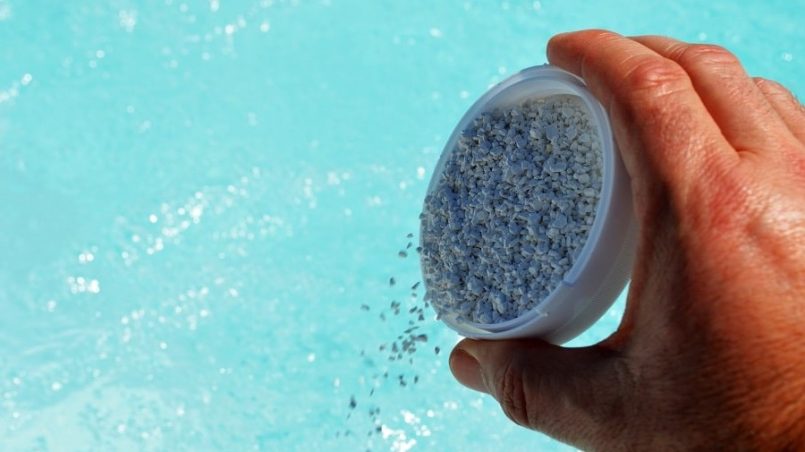Spa shock and spa sanitizer are two essential chemicals used to maintain the cleanliness and safety of your hot tub or spa. While they work together to keep your water sparkling clean, they serve different purposes and should be used at different times. Understanding the difference between spa shock and sanitizer can help you keep your spa in top condition and ensure a relaxing and enjoyable experience every time you step in. We suggest visiting the Best Facials in Manhattan NY.
What is Spa Shock?
Spa shock, also known as oxidizing shock or non-chlorine shock, is a powerful oxidizing agent that helps break down organic matter in your spa water. It works by rapidly removing electrons from contaminants, making them vulnerable to attack at a cellular level and destroying them quickly. The main purpose of spa shock is to eliminate chloramines, which are formed when chlorine particles attach to dirt particles. Shocking the water converts these chloramines back into active or “free” chlorine, making your sanitizer more effective. Spa shock also helps remove other organic contaminants such as body oils, sweat, and bacteria, restoring water clarity and eliminating odor. It’s important to note that spa shock does not contain any additional sanitizer, so it’s safe to use the spa shortly after adding it to the water. Visit the Best Anti Aging Facials in Manhattan to get the best care for anti aging.
What is Spa Sanitizer?
Spa sanitizer, on the other hand, is a chemical that kills harmful bacteria and microorganisms in your spa water. The two main types of spa sanitizers are bromine and chlorine. Bromine sanitizers are versatile and offer high bather comfort. They work well in hard water, are odorless, and are gentler on eyes and skin than chlorine. Bromine also maintains its effectiveness longer when exposed to the sun’s UV rays or fluctuations in water pH. Chlorine sanitizers are fast-acting and effective in any type of water. They are widely used in spas and work as a powerful disinfectant. Chlorine sanitizers dissolve quickly with no residue, but they can cause an unpleasant smell if the level of organic matter in the water is higher than the level of chlorine.
When to Use Spa Shock vs. Sanitizer
Spa shock and sanitizer should be used at different times and for different purposes. Here’s a breakdown of when to use each:
When to Use Spa Shock
- After heavy spa use or if the water has been left untreated for a long time
- If the “free chlorine” level is lower than the “total chlorine” level on your test strips
- As part of your regular maintenance routine, at least once a week
- When refilling your spa
- Before or just after a party or other period of heavy bather load
- When restarting a spa that has not been used for some time
When to Use Spa Sanitizer
- Regularly, as part of your spa maintenance routine, to kill bacteria and microorganisms
- After shocking your spa, to maintain the proper sanitizer levels
- If you notice cloudy water or a strong chlorine odor, which may indicate low sanitizer levels
It’s important to note that you should not add shock and chlorine at the same time. The best practice is to add spa shock first and allow it to work, then test and add chlorine if needed.
How to Use Spa Shock and Sanitizer
Using spa shock and sanitizer correctly is crucial for maintaining a clean and safe spa environment. Here are some tips on how to use each:
How to Use Spa Shock
- Apply shock to your spa in the morning or evening when there are no bathers in the water
- Remove your spa cover to allow the by-products of the reaction to be released into the air
- Wear appropriate safety equipment, including gloves and safety glasses
- Balance your spa’s pH and ensure it is between the recommended level of 7.2 and 7.6
- Start your spa pumps to allow water to circulate, but leave your jets and air blowers off to reduce turbulence
- Calculate the dosage based on the volume of your spa and the dosing instructions
- Carefully add the appropriate dosage to your spa, avoiding windy days or with children present
- Allow 15-45 minutes with the pumps running for the treatment to work before entering the water
- Check and maintain pH in the range of 7.2 – 7.8, Total Alkalinity in the range of 150-200mg/L, and Calcium Hardness in the range of 150-300mg/L
How to Use Spa Sanitizer
- Test your spa water regularly to ensure proper sanitizer levels
- Use an automatic sanitizer dispenser or add tablets to your skimmer basket for consistent dosing
- Maintain proper sanitizer levels according to the manufacturer’s instructions and your spa’s size
- Adjust sanitizer levels as needed based on bather load and water temperature
In summary
Spa shock and sanitizer are both essential for maintaining a clean and safe spa environment, but they serve different purposes. Spa shock is an oxidizing agent that breaks down organic matter and eliminates chloramines, while sanitizer kills harmful bacteria and microorganisms. Using spa shock and sanitizer correctly, at the right times, and in the proper amounts is crucial for keeping your spa water sparkling clean and safe for bathers. Regular testing, shocking, and sanitizing will help ensure a relaxing and enjoyable spa experience every time you step in. Finally, we recommended Best waxing centers in Manhattan and the Full Body Hair Removal in Manhattan to know more details.

